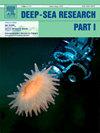Westward modification of Caribbean through-flow water mass structure
IF 2.1
3区 地球科学
Q2 OCEANOGRAPHY
Deep-Sea Research Part I-Oceanographic Research Papers
Pub Date : 2025-08-27
DOI:10.1016/j.dsr.2025.104581
引用次数: 0
Abstract
The Caribbean Through-Flow (CTF) is a critical chokepoint for North and South Atlantic waters that form the North Atlantic western boundary current system and the upper ocean limb of the Atlantic Meridional Overturning Circulation. While the circulation and energetics of the CTF have been well studied, its water mass transformations remain poorly constrained. Using over 7700 Argo float profiles from 2014 to 2024, we document a prominent westward modification in water mass structure across the Caribbean Sea. From the eastern to western Caribbean, we observe systematic increases in ocean heat content, a deepening of isopycnals, and a freshening and deepening of the subsurface salinity maximum. These changes result in a net mid-depth (∼50–500 m) density reduction of 0.40 ± 0.27 kg m-3. We hypothesize that regional variations in mesoscale eddy activity, complex bathymetry, and meridional wind stress curl gradients drive this transformation. The resulting water mass structure has critical implications for regional climate, weather, ecosystems, and sea level rise, as it modifies the density and stratification of source waters entering the Gulf of Mexico and North Atlantic western boundary current system. Our findings highlight the importance of internal Caribbean processes in shaping upper-ocean heat and salt transport in the Atlantic and underscore the need for sustained in situ observations in the region and targeted modeling analyses of the underlying modification processes.
加勒比海通流水团结构向西改变
加勒比海通流(CTF)是形成北大西洋西部边界流系统和大西洋经向翻转环流的上层海洋分支的北大西洋和南大西洋水域的关键阻塞点。虽然CTF的循环和能量学已经得到了很好的研究,但它的水质量转化仍然很不受限制。利用2014年至2024年的7700多个Argo浮子剖面,我们记录了加勒比海水团结构的显著西向变化。从加勒比海东部到西部,我们观察到海洋热含量的系统增加,等偏线的加深,以及地下盐度最大值的更新和加深。这些变化导致净中深度(~ 50-500 m)密度降低0.40±0.27 kg m-3。我们假设中尺度涡旋活动的区域变化、复杂的水深测量和经向风应力旋度梯度驱动了这种转变。由此产生的水团结构对区域气候、天气、生态系统和海平面上升具有重要影响,因为它改变了进入墨西哥湾和北大西洋西部边界流系统的源水的密度和分层。我们的研究结果强调了加勒比海内部过程在形成大西洋上层海洋热盐运输中的重要性,并强调了在该地区进行持续的原位观测和对潜在变化过程进行有针对性的建模分析的必要性。
本文章由计算机程序翻译,如有差异,请以英文原文为准。
求助全文
约1分钟内获得全文
求助全文
来源期刊
CiteScore
4.60
自引率
4.20%
发文量
144
审稿时长
18.3 weeks
期刊介绍:
Deep-Sea Research Part I: Oceanographic Research Papers is devoted to the publication of the results of original scientific research, including theoretical work of evident oceanographic applicability; and the solution of instrumental or methodological problems with evidence of successful use. The journal is distinguished by its interdisciplinary nature and its breadth, covering the geological, physical, chemical and biological aspects of the ocean and its boundaries with the sea floor and the atmosphere. In addition to regular "Research Papers" and "Instruments and Methods" papers, briefer communications may be published as "Notes". Supplemental matter, such as extensive data tables or graphs and multimedia content, may be published as electronic appendices.

 求助内容:
求助内容: 应助结果提醒方式:
应助结果提醒方式:


